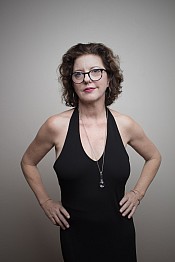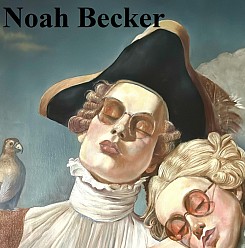Whitehot Magazine
December 2025
"The Best Art In The World"
"The Best Art In The World"
December 2025
Petra Mason on Horst P. Horst
 Horst P. Horst, Salvador Dali, New York, 1943. Archival black and white pigment print. Later Print by the Horst P. Horst Estate. Courtesy of the Horst P. Horst Estate and @theartdesignprojectgallery.
Horst P. Horst, Salvador Dali, New York, 1943. Archival black and white pigment print. Later Print by the Horst P. Horst Estate. Courtesy of the Horst P. Horst Estate and @theartdesignprojectgallery.
Horst P. Horst : Essence of the Times
Through April 16, 2023
&
Garden in Hell
Through February 28, 2023
By PETRA MASON, November 2022
With the recent resurgence of interest in Horst P. Horst's iconic images and 60 year career, Essence of the Times charts the breadth of Horst’s career while Garden in Hell showcases never-before-seen works from the Horst P. Horst archive.
PETRA MASON asked dual city curators Rafael Gomes (in Atlanta, Georgia) and Juan Carlos Arcila-Duque (in Miami, Florida) a couple of questions:
Curator Rafael Gomes (RG):
PM: Horst is often credited with bringing surrealist techniques and compositions into the world of fashion photography in the 1930s. What's your take on his work in this vein - including perhaps his most famous work from the decade, the Mainbocher Corset?
RG: Horst used surrealism to elevate fashion into something ethereal. Whether we’re talking about the Mainbocher Corset image or something like his work Birthday Gloves, there’s an otherworldliness that the surrealism influence brings. That could be the sense of beautiful, melancholic isolation seen in the image of the Mainbocher Corset or his ability to create something magical out of the ordinary, as seen in Birthday Gloves. Horst used photography to reframe these clothing items into something visually striking and unforgettable.
 Horst P. Horst, Mainbocher Corset (pink satin corset by Detolle), 1939. Archival black and white pigment print. Later Print by the Horst P. Horst Estate. Courtesy of the Horst P. Horst Estate and @theartdesignprojectgallery.
Horst P. Horst, Mainbocher Corset (pink satin corset by Detolle), 1939. Archival black and white pigment print. Later Print by the Horst P. Horst Estate. Courtesy of the Horst P. Horst Estate and @theartdesignprojectgallery.
PM: Horst’s late-career reprinting of many iconic works in platinum-palladium in the 1980s for museum and retrospective shows might today seem excessive. But it also brings to his work an atmosphere reminiscent of his black and white shoots of the 30s. Your thoughts?
RG: I believe the excess that went into reprinting and displaying Horst’s images highlights the respect and admiration held for his career. The eagerness to show his work after 50 years speaks highly of the continued interest in his work. The historic use of platinum palladium also dovetails nicely with the timeless influence of Horst P. Horst. As for the reminiscent nature, it was a very tidy and fortunate way to book-end his career. He continued working into the early 90s, but this revival and interest in the 80s acts as a great cap to his life’s work.
PM: Horst's career straddled major shifts in the relationship between photographic technology and fashion - from large-format cameras and full studio sets in the 1930s, to his detours into nature and architectural photography and nude studies, for example. What's your take on this?
RG: We’re incredibly lucky to showcase an artist with such an extensive career where his photographic point-of-view was in demand for decades. Horst had the time and technology to experiment with his style and relationship with art over his extensive career. While his talent certainly remained consistent, his work details the nascence of fashion photography with these theatrical, fabricated sets and fashionable elites as models as it evolves to the fashion photography we’re more familiar with, featuring models with household names. All of that is not to mention his wonderful lifestyle images, which give us an insight into the intimate lives of designers and society’s muses.
PM: He has been most influential in his career on the relationship between photography and designer fashion. What is the nature of that influence in your view?
RG: We worked with Gert Elfring of the Horst P. Horst Estate and Juan Carlos Arcila-Duque, curator of The Art Design Project in Miami, to display these Horst works as pieces of art, and guests will also realize that these images also incredible examples of persuasive photoshoots used to advertise and sell clothing and accessories. His ability to make images that are in and of themselves art and excellent fashion imagery is something we aimed to showcase in this exhibition.
PM: What would Horst have made of the age of the smartphone selfie and social media influencers?
RG: I’m sure he would appreciate the surrealist nature of the subject capturing their own image as a public performance of oneself. As you can see in his work, Horst was willing to experiment and change with the time, so I believe he would have been open to this new world!
 Horst P. Horst, American Vogue cover, May 15, 1941. Archival color pigment print. Later Print by the Horst P. Horst Estate. Courtesy of the Horst P. Horst Estate and @theartdesignprojectgallery.
Horst P. Horst, American Vogue cover, May 15, 1941. Archival color pigment print. Later Print by the Horst P. Horst Estate. Courtesy of the Horst P. Horst Estate and @theartdesignprojectgallery.
And Juan Carlos Arcila-Duque (JC):
PM: Tell us a bit about how these Horst Exhibitions came about?
JC:We have been working with the Horst Estate for almost two decades, curating many exhibitions around the world, and I consider the owner of the Estate; Gert Elfering, my mentor in the world of photography.
PM: Why was Horst considered “the light master”?
JC: Horst was trained as an architect and always worked with natural light and developed the concepts of all the sets. For him it was all about the entire composition. For a decade he not only photographed fashion, he documented interiors and exquisite compositions with plants and Greek sculptures. His compositions were always alive, because he always used natural light.
PM: Do you remember the first time you encountered a Horst image?
JC: I was introduced to the world of Horst P. Horst by the legendary New York gallery couple Wessel + O’Connor. After a decade in NYC, I moved to Miami to open my art and design gallery and was introduced to Gert Elfering. Thanks to him I was able to show the work of Horst, Helmut Newton, Peter Beard, Sarah Moon, Albert Watson and many other masters of photography at my gallery where we’re proud to promote the intersection of art and design, representing the work of emerging and established artists from around the world. WM

Petra Mason
Cultural historian and vintage photography book author published by Rizzoli New York. Founder Obscure Studio and ArtHit. Whitehot arts and culture contributor since 2016.
Photography by (c) Thekiso Mokhele / Obscure Studio
view all articles from this author







